The MR of ptns maintained on HDX is unacceptably elevated. With higher morbidity, relatively lowered quality of life
Technical
aspects of nocturnal hemodialysis (NH)
Abbreviation
(read twice please):
o
Ca+ Cl-: Calcium Chloride
o
Ca+: Calcium
o
CI: contraindications
o
CKD: chronic
kidney disease
o
Conc: concentration
o
CVC: central
venous catheter
o
CVS: cardiovascular
o
DX: dialysis
o
Dzr: dialyzer
o
Dzt: dialysate
o
FHN: the
Frequent HDX Network
o
HCO3: Bicarbonate
o
HDX: hemodialysis
o
HH: home
hemodialysis
o
K+: Potassium
o
KTx: kidney
transplantation
o
LMWH: low-molecular-weight
heparin
o
MR: mortality
rate
o
Na+: Sodium
o
Na+PO4: Sodium
Phosphate
o
ND: nocturnal
dialysis
o
NH nocturnal
hemodialysis
o
PD: peritoneal
dialysis
o
PTH: Parathyroid
hormone
o
QB: blood
flow rate
o
RCT: randomized
controlled trial
o
Sms: symptoms
o
tPA: tissue-type
plasminogen activator.
o
UF: ultrafiltration
The MR of ptns maintained
on HDX is
unacceptably elevated. With higher morbidity, relatively lowered quality of
life (considering the higher level of dependence on others and unemployment), with
higher costs of care have also been reported. The HDX (HEMO) study reported
that a higher DX dosing
within the general restriction of a thrice-weekly schedules failed to limit
ptn MR. The institution
of more intense DX schedule seems
to be improving morbidity & possibly MR in this ptns
cohort. As compared to the conventional thrice weekly schedule, ptns DX with prolonged
duration and/or higher frequency could be correlated to better outcomes.
Considering
these findings, NH (e.g., long
nightly HH) was suggested as a
(possible) more accepted alternate to the conventional DX as it’s superiorly providing DX based on dosing, duration, and frequency.
This can be achieved as it’s provided during night
sleeping on otherwise unproductive timing. I will discuss the NH, especially the current regimen of this
procedure.
DX
REGIMEN & PRESCRIPTION
Regimen
schedule: NH can be
provided either at home or in a DX facility.
If it’s provided at home, the frequency of DX
varies between 3-7 nights/week. Facility-based NH is provided
3 nights a week.
Personnel: Facility-related DX is usually performed by an attending staff.
Home DX is performed through the ptn himself or
via a helper (paid/unpaid). An attended partner is NOT absolutely mandated
for nocturnal DX at home, as this
procedure is usually associated with a significantly hemodynamic stable ptn.
HDX
machines: NH can be accomplished
with any HDX machine. Attractive facilities
of a HH machine may include:
o
Easy operation/disinfection,
o
Single-needle
facility,
o
Lowered
noising production,
o
Remote
monitoring facility of the ptn.
o
Easily
accessed screen diming at night,
o
Back-up
batteries to guard against power failure, &
HH machines can provide
high or low Dzt flow. The available machines
that approved for HH in the US are: Fresenius 2008K, NxStage One & One S, & Tablo.
Dzr
membrane: Any Dzr membrane
can be provided, including smaller surface area Dzr.
Although there’re no published reports favoring one type of Dzr over others, most centers are providing high-flux Dzrs.
Time: NH is preferably with sleeping for a different
amount of time (usually 6 to >10 hs), according to the targeted length of sleep.
For facility-based DX, the duration
of the DX session is usually given by
the facility logistics.
Dzt
composition: is variable
according to the type of DX machine
(high/low flow).
High
Dzt flow (conventional) machines: Typically composed of:
o
Na+: 138 mEq (mmol)/L.
o
K+: 2 mEq (mmol)/L.
o
HCO3: 30 mEq
(mmol)/L for nightly schedule & 35 mEq (mmol)/L for every other night
or thrice-weekly schedules.
o
Ca+: 2.5-4 mEq/L (1.25 -2 mmol/L), averaging of 3.2 mEq/L (1.6 mmol/L). Dzt Ca+ is
adjusted to preserve PTH in a
desired range while keeping normal pre-DX Ca+. Dzt Ca+ can be adjusted by changing the amount of Ca+ Cl- powder added
to the Dzt (e.g., 7 mL of Ca+ Cl- powder
added to 4 L of acid Dzt concentrate
can increase the Ca+
by 0.5
mEq/L [0.25 mmol/L]).
o
An
increased Dzt
Ca+ may be provided in ptns with high UF volumes to
guard against the negative Ca+ balance. As removing Ca+ (ionized)
with HDX is generally proportional with the
volume of the UF volume. Moreover,
pregnancy or hungry
bone syndrome also
requiring higher levels of Dzt Ca+.
o
PO4: 0-4.5 mg/dL (0-1.5 mmol/L), ideally 1.2 mg/dL (0.4 mmol/L). Na+PO4 (as Fleet
enema) is usually added, if required, into the acid or HCO3 concentrate.
Dzt PO4 is
adjusted to keep pre- & post-DX PO4 within normal range. Typical dosing is 30-60 mL per Dzt concentrate
jug, but higher dosing of 200
mL can be provided as a source of PO4 for ptns with increased requirements, those
ptns who’re pregnant or with hungry bone syndrome. Ca+ & PO4 do not
precip-itate in the acidic pH. Intermittent NH is less
likely to need PO4
additives.
Low
Dzt flow machine: Dzt
composition of the low Dzt flow
machine (i.e., NxStage) is usually fixed
that it cannot be altered during DX session.
o
Na+: 140 mEq
(mmol)/L
o
K+: 1-2 mEq
(mmol)/L
o
Lactate: 40 or 45
mEq
(mmol)/L
o
Ca+: 3 mEq (1.5
mmol)/L
According
to the given Dzt volume, a higher lactate conc
of 45 mEq/L is
used with low Dzt flow machine may elevate
serum HCO3 excessively.
No Dzt
additives are possible with using the NxStage machine.
Blood
and Dzt flow rates: With conventional DX machines, a blood flow as low as or < 200
mL/min is adequate for most ptns undergoing NH.
However, a blood flow of 200-300 mL/min may be typically provided. QB with low Dzt
flow machines (i.e., NxStage) is higher
(>300
mL/min) to keep the widest blood/Dzt solute
gradient.
Dzt flow rate is
variable, depending on the type of DX
machine. For a high Dzt flow machine,
Dzt flow is ranging from 100-800
mL/min. The Dzt flow in a lower Dzt flow machine can’t be < 63
mL/min. So, the entire Dzt volume is
required to be monitored to accommodate the target duration of therapy.
UF: The
typical daily UF volume removal is about 1-2
L, however, higher volumes can be tolerated. Ptns must weigh themselves daily
to keep their dry weight, defined as:
normotension with no need for
antihypertensive agents or edema.
Dzr
reuse: Reprocessed delayed
Dzr has been utilized. Certain DX machines may be used in situ Dzr reprocessing. Many centers mostly providing
new Dzrs.
Anticoagulation: To
provide systemic anticoagulation, the
standard heparin regimen can be administered as 1000
units heparin/h. Danaparoid & argatroban can
also be provided successfully with heparin
allergy. A single dose of LMWH at the start of DX
has been successfully applied.
Access: Both
CVC & peripheral vascular access
have been successfully applied in NH.
If peripheral access is used, however, several access cannulations may induce lowered
access survival. This was suggested by the FHN
Daily & Nocturnal trials, where the primary vascular outcome was
the timing to 1st access event (repaired access, lost access, or
access with hospitalization), and the secondary vascular outcome was the timing to all
repairs and timing to all losses.
In
the FHN Nocturnal
trial, 87 ptns were receiving in-center, 6
d./week HDX or conventional, 3 d./week HDX.
As compared to conventional DX, there
was a non-significant attitude toward an increasing rate of 1st access
event with ND. If ptns with tunneled
catheters were excluded, ND was complicated
with a significantly higher risk of a 1st access event. In the FHN Daily
trial (n = 245 ptns), there was a higher trend of the 1st access
events in the daily group as compared to the conventional group.
Catheters: Any
type of CVC
can be utilized for NH. The ability
of the catheter to provide blood flow >200 mL/min is not important for most ptns.
A safe connection for the CVC includes using pre-perforated catheter caps that’re
not removed during DX. Careful taping of the catheter-tubing is crucial.
Accidentally disconnected venous limb may induce exsanguination without triggered
machine alarms.
Complications
o
Thrombosis: Locally
instilled 2 mg of alteplase (tPA) has been
successfully restored an accepted blood flow in the blocked catheters. With instilled
lyophilized tPA, it can
be practiced successfully by ptns at home. The approach to manage the catheter
thrombosis is varying in different centers. Prophylactic tPA has been suggested
to guard against catheter thrombosis.
o
Infection: DX catheter-related
infection can be seen with ptns on HH using a temporary or tunneled DX catheter.
Study: 98 ptns on NH utilizing
catheters, 64 % were complicated by bacteremia along 7 ys; the most common
isolated pathogen was S.
epidermidis (51 %).
The
frequency of these infections with HH
can be compared to that in ptns on in-center HDX,
e.g., one study compared the rate of 1st catheter infection
among these groups, ptns on HH had
somewhat fewer episodes of infection (1.77 vs 2.03 /100 ptn-mo,), despite the
difference between groups was insignificant.
Arteriovenous
(A/V) fistulas: An A/V fistula is the preferable
access. The standard steel needle, blunt needle, & plastic
cannulas have been utilized safely. The buttonhole pattern involving the inserted needle/cannula
through exactly the same hole and at the same
angle and depth of penetration, can
be applied by most ptns. After 8-10 cannulations (or 12-14
in diabetics) with the buttonhole method, an epithelialized track will be developed
allowing using of the blunt needle. Sharp needle should be utilized in the 1st
week, followed by "blunt" ones thereafter. Before cannulating, the
fistula and surrounding skin are disinfected with chlorhexidine
gluconate (0.5% in 70% alcohol)
or povidone-iodine disinfection. Scabs can be covered with an
alcohol pad for 5 min., then removed with a sterile needle. Mupirocin Ca+
2% cream (Bactroban) can be applied to each buttonhole using a
sterile cotton swab after reaching hemostasis and permitted for air dry.
A
single set is given for each HDX session.
Using Mupirocin for prophylaxis seems to
significantly limit the risk of S. aureus bacteremia with buttonhole technique. The Buttonhole
technique without using local Mupirocin can
be complicated with S. aureus bacteremia,
usually with life-threatening metastatic sepsis. Risk of sepsis was assessed in
the following reports:
●A RCT comparing
140 conventional HDX ptns
assigned to either the buttonhole technique or "rope-ladder" bricking.
After 8 weeks, the rate of localized sepsis was higher among ptns on the buttonhole technique in comparison
with conventional bricking (50 vs 22.4/1000, resp). One episode of S. aureus bacteremia
at 8 weeks and 2 more episodes within 12 mo after the study was terminated in
the group utilizing the buttonhole maneuver vs none in the conventional one. At 12 mo, the number
of bricking site abscesses on need to IV AB was higher
in the buttonhole group vs
the conventional one (9 vs zero, resp.). The degree at which this information
from conventional HDX ptns could
be extrapolated to nocturnal daily HDX or self-cannulating ptns is not certain.
●A retrosp. review comparing the buttonhole maneuver with rope-ladder
cannulation among 90 HH ptns.
Over 3765 A/V fistula-months, there were 17 systemic infectious episodes related to
fistula infections. As compared with rope-ladder, the buttonhole maneuver
was complicated with an increased rate of total fistula (non-systemic)
infection. Lost
fistula or requiring surgical
intervention was similar
between the groups, despite intervention by the radiologist was not included in
the analysis. An accompanied systematic reviewing also reported higher risk of
infection with the buttonhole
maneuver as compared with other maneuvers in
4 RCT, as well
as in observational reports.
So,
considering the higher risk of infection, avoiding the buttonhole
maneuver has been recommended by some clinicians. However, S. aureus bacteremia
has been rarely seen with the introduction of mupirocin. Most centers do not practice the buttonhole maneuver
for facility-based DX.
The
buttonhole maneuver may be complicated with fewer thrombotic sequalae
among ptns on nocturnal/daily DX. In
the FHN report,
compared with the rope-ladder maneuver, the buttonhole maneuver was correlated
with prolonged intervals between access-related event(s) that could be
correlated mostly by the reduced thrombotic events. The buttonhole maneuver may
be also improving fistulae survivals among ptns on conventional HDX. Regardless the technique (i.e.,
buttonhole vs rope ladder), more frequent cannulation may induce to more
frequent access-related sequalae.
A/V grafts: have been successful. The buttonhole maneuver
is not applied with this access. A different hole is utilized with every
DX. A steel needle or plastic cannula
can be used. Superiority should be directed to the single-needle technique
to limit the number of cannulations. The single-needle maneuver can provide accepted
blood flow (average 200 mL/min), it provides more safety with
accidental disconnection by triggering the air-detecting alarm. So, it could be
the access maneuver of
choice for NH.
SAFETY: Safety while on HH
is of outmost importance. HH is
generally considered to be safer,
provided that ptns are strictly selected,
well-trained, and observing the given
safety maneuvers. One report: 2 adult HH
programs (Canada), there was only one death and 6
potentially fatal events among 190 ptns and about
500 ptn-ys
of treatment; 6 of the 7 events include bleeding,
and 5 of 7 involved a human error with lapsed established protocol.
To
assure the safety of this procedure, tight needle
taping with anchored blood tubing
is crucial; enuresis pad wrapped around the connection is also important. 2 moisture sensors are
placed on the floor to recognize any Dzt
or blood leaking. Blood leak can trigger the audible
alarm. Dedicated disposable leak sensors are available, as well as
non-disposable wireless leak sensors that stop the blood pump when triggered.
More
recent technologic updates have been admitted, e.g., a tight clamp connected to
the blood-loss sensor with clamping the venous line on sensing any moistening with
forcing the DX machine to be held and
alarming.
As
noted above, a single-needle maneuver is providing an extra
safety with accidental
disconnection via triggering an air detector alarm. Certain centers may be practicing
the live remote monitoring of ptns at home. All the data present on the DX machine, including the triggered alarms, are
also obviated to an observer at the following center. Ptn who was not awakened
by the current alarm will be called. Live monitoring may provide the
following benefits:
o
Data collection
o
Ptn reassurance
o
Ensured
compliance
o
Preventing
blood clotting within an idle extracorporeal system
Despite
the aforementioned benefits, this monitoring may not be detecting the life-threatening states. So, its application is
optional. Most centers do NOT apply the remote monitoring of ptns on NH, despite some centers may use remote
monitoring for certain ptns or for short periods (3 mo.s).
PATIENT SELECTION & TRAINING: All ptns with ability of practicing HH or ptns with home
helper are candidates for NH. Exclusion criteria may include
1)
Acute illness,
2)
Resistant seizure
activity,
3)
Labile
type 1 DM (with no helper), &
4)
CI to systemic anticoagulation.
The
finding of older age, unstable CVS system, hypotension, DM, and/or ascites are ALL indications, and NOT CI, for NH.
A given aid to encourage home DX choice
for ptns has been provided. Ptns cohorts that can be preferably targeted for NH may include:
o
Ptns
following in a CKD clinic. Preventing
the dependence setting commonly seen in in-center DX units,
training them should be commenced early or ptns may be dialyzed temporarily as
self-care therapy. Utilized transitional care unit setting is growing leading to an increasing number of
ptns choosing HH.
o
Ptns ineligible
for KTx. NH can be offered
as a DX modality nearest
to KTx.
o
Ptns with
significant morbidity, e.g., cardiac disease, DM, severe HT, DX-related Sms, or higher
interdialytic weight
gain.
o
Ptns requiring
shifting from PD to HDX or wanting
to keep independence.
o
Large-sized ptns or ptns
with inadequate DX due to inadequate access flow.
The
adopted NH
could be precluded by ptn-related barriers, including lacked confidence in his own ability to
perform the desired duties (e.g., self-cannulating),
fearing of devastating events, and the reluctance in regard to burden family
members/caregivers. Financial burden could be of concern. Costing may include higher
home utility fees and lowered DX reimbursement
schedule, particularly if > thrice-weekly DX
will be provided.




















COMMENTS